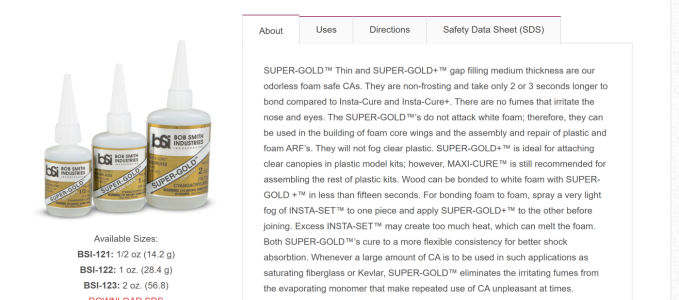I have read your article with great interest since I also suffer with severe allergy from CA glue. However, my symptoms are quite different. I don’t have nasal or inhaling problems but it affects my skin everywhere (legs, arms, hands and back) with severe itching and scratching. As a result very bad sleep and an Admiral complaining about bloody sheets. Treatment was always with an ointment containing cortisone wich in turn makes the skin thinner and more susceptible to tearing and that was happening exactly when playing golf. So in one stroke two hobby’s gone.
As a result I have not worked on my S.O.S. for more then 2 years now and golf is restricted to max 18 holes per week so I am very very much interested to try your replacement CA and also start working on the rigging.
Thanks!.
As a result I have not worked on my S.O.S. for more then 2 years now and golf is restricted to max 18 holes per week so I am very very much interested to try your replacement CA and also start working on the rigging.
Thanks!.





 /dp/B01MQKNC5C/ref=sr_1_5?adgrpid=1340305240855225&dib=eyJ2IjoiMSJ9.Apy3BhWn4e-VM9gk_Hlmq4Gl64VKwNES7yt03vAmvrQ2mq5oVIgHPnLIeOGdUJFVxmVuJhoDh7ewEyYrXlaFfvgqSZv7TSdFWFXsCQ02yNJQ7D2q0ev1Pmdcs0NNLrwUvjb4naZ7F5ynR6OH5854ZGq1Qm0-kpWEIqQuyAYB-CCC4ftkd-ft2JvVuwU-0d13kxqPIhjBp2GPuryE9tFK4Z5hB-9D9rNbDKkSg9zl_BHNJxDRQSw7U1VjXgc7Ad6xeV-A8R-G6zrH30WhjgR-7VuiGvQWHG0o53fxoOH8RUKHOCvrCLCjEunGJPipUAakYW-MoyL3QSSedn9WdHgiBbHh38CHILJyV_-Kyu89_8xywencP9Xtii0Eb7sIRVyXQXxpud7b6TXD2Bn0rVQGIzxo2DdsmblQjorbfi9IEqE0NXz7XLof7ezDYbbU_nCg.9NSQYcKyu9XM0Gw8I8GTqgERsPRdAstB2MkC-yMu6Qw&dib_tag=se&hvadid=83769464193605&hvbmt=be&hvdev=c&hvlocphy=88716&hvnetw=o&hvqmt=e&hvtargid=kwd-83769431092619:loc-190&hydadcr=26614_11815972&keywords=fish+glue&msclkid=8e10eb53de1c1da6066e8ccd54ad578f&qid=1738443448&sr=8-5
/dp/B01MQKNC5C/ref=sr_1_5?adgrpid=1340305240855225&dib=eyJ2IjoiMSJ9.Apy3BhWn4e-VM9gk_Hlmq4Gl64VKwNES7yt03vAmvrQ2mq5oVIgHPnLIeOGdUJFVxmVuJhoDh7ewEyYrXlaFfvgqSZv7TSdFWFXsCQ02yNJQ7D2q0ev1Pmdcs0NNLrwUvjb4naZ7F5ynR6OH5854ZGq1Qm0-kpWEIqQuyAYB-CCC4ftkd-ft2JvVuwU-0d13kxqPIhjBp2GPuryE9tFK4Z5hB-9D9rNbDKkSg9zl_BHNJxDRQSw7U1VjXgc7Ad6xeV-A8R-G6zrH30WhjgR-7VuiGvQWHG0o53fxoOH8RUKHOCvrCLCjEunGJPipUAakYW-MoyL3QSSedn9WdHgiBbHh38CHILJyV_-Kyu89_8xywencP9Xtii0Eb7sIRVyXQXxpud7b6TXD2Bn0rVQGIzxo2DdsmblQjorbfi9IEqE0NXz7XLof7ezDYbbU_nCg.9NSQYcKyu9XM0Gw8I8GTqgERsPRdAstB2MkC-yMu6Qw&dib_tag=se&hvadid=83769464193605&hvbmt=be&hvdev=c&hvlocphy=88716&hvnetw=o&hvqmt=e&hvtargid=kwd-83769431092619:loc-190&hydadcr=26614_11815972&keywords=fish+glue&msclkid=8e10eb53de1c1da6066e8ccd54ad578f&qid=1738443448&sr=8-5




